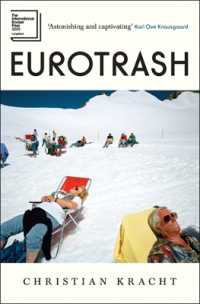Full Description
Building on the foundations of human geography and regional science, there has now emerged a powerful theoretical basis that underpins a spatially integrated approach in social science research. This approach explicitly recognizes the key role that geographical (or spatial) concepts - such as distance, distribution, location, proximity, connectivity, place, neighborhood and region - play in human society and the behavior of individuals, groups and organizations. It also promotes research that advances the understanding of spatial patterns and processes.The chapters in this unique Handbook provide broad coverage of the theoretical foundations and methodologies that typify research using a Spatially Integrated Social Science (SISS) approach. This insightful volume is intended chiefly as an introduction for students and budding researchers who wish to investigate social, economic and behavioural phenomena by giving explicit consideration to the roles of space and place. The majority of chapters provide an emphasis on demonstrating applications of methods, tools and techniques that are used in SISS research, including long-established and relatively new approaches.
Accessible and packed with key instructions on organizing SISS research, the book is structured into five distinct parts which give the reader a unparalleled overview of the field:
- A Spatially Integrated Social Science Approach
- Setting Up Your Research
- Data Sources, Data Collection and Information Generation
- Research Tools and Techniques and Applications
- Producing Research Output
This volume will appeal to all students and researchers with an interest in understanding the techniques, method and application of the spatial dimension of social sciences.
Contributors: Imran Azeezullah, Irfan Azeezullah, A. Beer, M. Bell, D. Brown, C. Brunsdon, P. Chhetri, J. Corcoran, G. Daraganova, D. Faulkner, M. Goodchild, K. Grossner, A. Harding, K.E. Haynes, B.W. Head, G. Hugo, D.G. Janelle, R. McCrea, T. McGee, P. McGuirk, L. Mazerolle, W. Mitchell, A. Murray, K. O'Connor, P. O'Neill, L. Mazerolle, P. Pattison, J. Poot, K. Risley, D. Rohde, T.-K. Shyy, A. Sorensen, R.J. Stimson, R. Stough, R. Tanton, M. Watts, M. Western, R. Wickes
Contents
Contents:
Preface
Robert J. Stimson
PART I: A SPATIALLY INTEGRATED SOCIAL SCIENCE APPROACH
1. A Spatially Integrated Approach to Social Science Research
Robert J. Stimson
2. Critical Spatial Thinking
Michael Goodchild, Donald G. Janelle and Karl Grossner
3. Time Space Convergence
Donald G. Janelle
PART II: SETTING UP YOUR RESEARCH
4. Approaches to Conducting Research
Robert J. Stimson
5. The Literature Review: The Fundamental Element of a Research Project
Kevin O'Connor
PART III: DATA SOURCES, DATA COLLECTION AND INFORMATION GENERATION
6. Issues to do with Data
Robert J. Stimson
7. Using Census Data: An Australian Example
Graeme Hugo
8. Survey Research Methods
Robert J. Stimson
9. Using Quantitative Data in the Social Sciences
Mark Western
10. Qualitative Methods in Socio-spatial Research
Philip O'Neill and Pauline McGuirk
11. How to Use Primary and Secondary Data
Andrew Beer and Debbie Faulkner
12. Forecasting in Social Science Research: Imperatives and Pitfalls
Tony Sorensen
13. Meta-Analysis of Previous Empirical Research Findings
Jacques Poot
PART IV: RESEARCH TOOLS AND TECHNIQUES AND APPLICATIONS
14. Classification for Visualizing Data: Integrating Multiple Attributes and Space for Choropleth Display
Tung-Kai Shyy, Imran Azeezullah, Irfan Azeezullah, Robert J. Stimson and Alan T. Murray
15. Spatial Indexes: A Focus on Segregation
Martin Watts
16. Shift Share Analysis: Decomposition of Spatially Integrated Systems
Kingsley E. Haynes and Jitendra Parajuli
17. Spatial Econometric Modelling
William Mitchell
18. Spatial Clustering: Issues and Methods for Identifying Industry Clusters
Roger R. Stough
19. Analysing Spatial Interactions: Inter-regional Migration Flows
Martin Bell and Dominic Brown
20. Using Circular Statistics to Analyse Spatial Flow Data and temporal data
Jonathan Corcoran and Chris Brunsdon
21. Analysing Human Social Networks
Galina Daraganova and Philippa Pattison
22. Modelling the Effect of Intervening Variables Using Path Analysis
Rod McCrea
23. Merging Survey and Spatial Data Using GIS-Enabled Analysis and Modelling
Prem Chhetri and Robert J. Stimson
24. Web-based GIS to Support Visualization and Analysis of Community Variations in Crime
Tung-Kai Shyy, Lorraine Mazerolle, Kate Risley and Robert J. Stimson
25. Policy and People at the Small Area Level: Using Micro-simulation to Create Synthetic Spatial Data
Ann Harding and Robert Tanton
26. Graphical Models and Bayesian Networks as a Spatial Analytical Tool
David Rohde and Jonathan Corcoran
PART V: PRODUCING RESEARCH OUTPUT
27. Research and its Policy Relevance
Brian W. Head
28. Navigating a Successful Doctoral Research Experience
Rebecca Wickes and Tara McGee
Index







